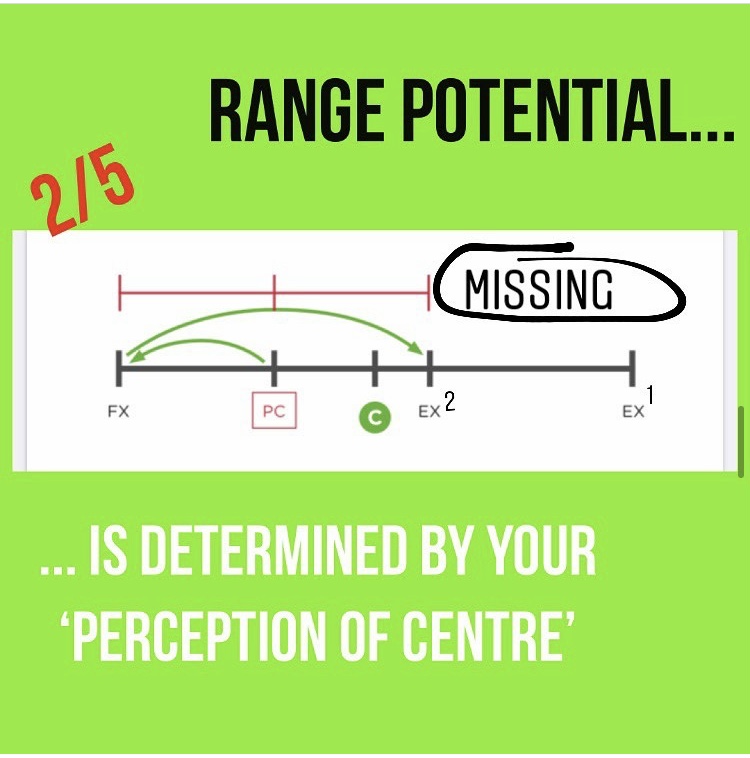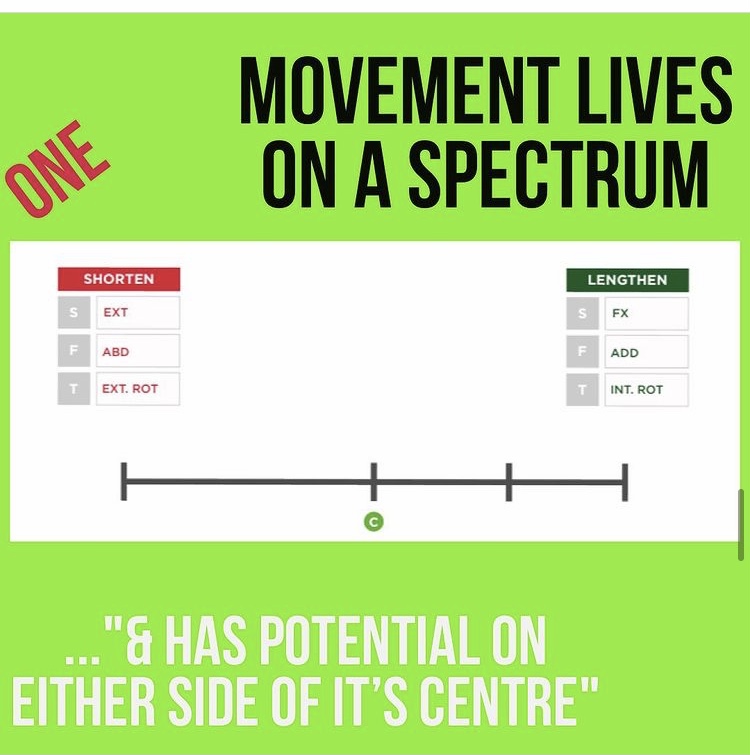👣 Movement lives on a spectrum.
👣 A spectrum in this case being a line between two extremes. In each plane of movement, there are two options for movement of a joint towards each extreme within the plane.
Flexion⬅️➡️Extension
Adduction ⬅️➡️Abduction
Internal Rotation⬅️➡️External Rotation
👣 There are other ways of describing the planes of movement at different structures in the rest of the body too. What’s important is where you sit on that spectrum/continuum.
👣 In the picture I show my way of thinking about this. You have two extremes either side of a central midpoint. A healthy joint, would easily be able to access both ends of this spectrum AND to have the best chance of doing so, would rest easy in that central position (in all three planes). Why? Well, this is where all of the muscles have equal opportunity to lengthen and shorten and all joints have equal access to both ranges.
👣 Where it becomes useful is to notice where on the spectrum you sit. Are you more flexed than extended in your spine? Or your hip? Or your shoulder?
👣 If you are more flexed than extended, the amount of flexion left available to you is reduced, and while it may seem that you have more extension available, the opposite is in fact true, by virtue of a reduction in overall joint range in both directions.
👣 As all joints are interconnected, no joints can now be resting in that preferred centred position and so all favour one extreme or the other. Putting all joints together, this equates to a description of your overall posture. One joint too flexed, another joint too extended, a third joint more internally rotated etc. You are the sum of all your parts. What this means is that your posture is an outcome of your movement potential within each joint and equally that your movement potential in the joints is at the mercy of your posture.

👣 Above I suggested that a joint may be more flexed than extended at rest and taking this into account over many joints will contribute to the resting posture you currently hold. It’s ok to say I have a forward head posture, flat feet and a sway back… but is it really enough? Such terms lead us to cookie cutter exercises that seek to improve the posture. But we can be doing way more.
👣 Instead of thinking about it as just your posture, what about thinking about it as your perceived centre? A sum total of the resting position of each joint in the body. This is what I call your ‘Perception of Centre’ (POC). Despite us talking about having bad posture, we might want to consider that the posture you currently hold is the most efficient way to hold your body and move around in given the outcome of each joint’s placement along it’s respective spectrum. Begs the question why we don’t all stand up tall and perfect as that naturally would be our most efficient posture – the answer is we can’t, otherwise we would – so what’s holding us back?
👣 We all stand in our perception of centre. If this perception of centre is not challenged (using a cookie cutter approach), it will likely remain the same.
👣 One way to begin to unravel this is to begin to pay attention to all of the structures in your body and assess where they are resting on this spectrum. See the red line on top of the image…? That is your new overall joint range potential given the change in POC along the spectrum of what is possible at the joint (in this case towards being more flexed). The absence of red line towards the extension end of the spectrum is what we call “What’s Missing!”
👣 Your job, through movement as a practitioner or a patient taking ownership of their own body, is to re-educate and re-experience that missing part of the movement. Ideally you would eventually piece all of the “What’s Missing’s” together to make lovely long chain integrated movements.
👣 This re-education of the whole body’s movement potential encourages each joint to find it’s new POC and is what ultimately lends itself to finding a new posture and taking any existing pressures off the system.

👣 In a flexed joint, muscles of flexion will be short and muscles of extension will be long. No brainer, right? The problem with stretching and strengthening a muscle around a joint’s perception of centre is that if we do not give the joint a strong enough reason to re-centrate itself, then the muscle will never enjoy its fullest capacity. A flexed joint puts persistent shortness in the flexor muscle and persistent increased length tension in the extensor muscle. This difference in muscle length is commonly known as imbalance, and we can say that it comes from the joints resting position. We could also argue (and many do) that the joint position comes from the length tension imbalance in the tissue. This may have happened at one joint – say from an impact – but the knock on response from one joint to all other joints mean that the rest of the muscles in the system are at the mercy of the joint system again.
👣 We now know that joints integrate and communicate with those above and below and operate in three planes of motion. We know that muscles manage the joint but are not overpowering enough to dictate the joint’s ultimate outcome. “Joints ACT and muscles REACT” is a mantra we use to remind ourselves that the joint’s perception of centre determines it’s – and the surrounding tissue’s – potential. By challenging the joint’s perception of centre, introducing to it, those missing ranges (previous post) and communicating the new movement to joint structures above and below (whole body movements) means that the muscles finally get their chance. Their chance to experience full range and manage a centrated joint. That is when the muscle can do its job from a balanced position, rather than an imbalanced position which naturally can cause you problems in the long run.
👣 I get the feeling some people are struggling with the concepts in these posts which is why I chose to write them. For me thinking about muscles the way we were all taught doesn’t help the big picture. Mapping the gait cycle completely changed the way I think about and work with muscles and has been an incredibly valuable and effective approach to working with the human body.

👣 One way of taking this postural consideration is to draw it up in all three planes exactly how your assessment perceives it to be. From this you may start to get the ‘state’ of each joint and where it sits along its own little spectrum, how it influences or is influenced by those joints around it, both near and far. When you are stood up, a difference in the left foot to the right foot will reach all the way up the body. Affecting everything. What is that whole body response? What does it look like? What does it mean for the joint system and what does it mean for the muscle system?
👣 Looking at the picture above, you may begin to get the idea that a non-centrated joint, leading to a sequence of other non-centrated joints creates an overall posture that suggests that some joints will be closed while others will be open. Closed joints couple closely with shortened tissues while open joints couple closely with lengthened tissues. Closed joints are generally compressed or compressing, while open joints create a lengthened tension in the system. A long muscle is working hard to bring that joint back toward centre (but can’t due to the overall aggregate of all other joints) and thus remains under constant tension. This is the type of muscle we are typically advised to stretch 🤷🏻♂️
👣 We have lots of names for discomforts. -isis -osis -syndrome -dysfunctional; countless labels. Looking at the body this way you simply get to see what is under compression and what is under tension.
👣 What would you like to do to something that is compressed? What would you like to do to something under tension? Easy right? Can you see how considering the perception of centre, factoring in “What’s missing?” and reintroducing those missing movements make it easier to reduce compressions and tensions in the system, than to worry about treating the ‘label’? We currently have treatments for the label that are not affecting the whole system. What if we could treat / move the whole system so the label no longer exists as our bodies begin to find a new centre?

👣 So after all that what on earth could be missing?
👣 Well actually this is quite straightforward and we address each of the following key movements in our Wake Your Body Up and Wake Your Feet Up programmes.
👣 In each of the following you will be either able to do both, neither or one or the other:
Pelvis:
Anterior tilt⬅️➡️Posterior tilt
Hike⬅️➡️Drop
Rotate left ⬅️➡️Rotate right
Ribcage and Skull (separately of course):
Anterior tilt⬅️➡️Posterior tilt
Side bend left ⬅️➡️Side bend right
Rotate left ⬅️➡️Rotate right
Spine:
Flexion ⬅️➡️Extension
Side bend left ⬅️➡️side bend right
Rotate left ⬅️➡️Rotate right
Hips:
Flexion⬅️➡️Extension
Adduction ⬅️➡️Abduction
Internal Rotation⬅️➡️External Rotation
👣 What can you do in your body? And what can’t you do? Tick off ✅ which movements you can’t do and make that your physical focus. Can you re-educate your brain to learn to access these lost movements once again? By doing so you will enable your body to find a new centre, one that reduces tension and compression in the system, alters your posture for the better and makes your movement more efficient, more effective and effortless🤞🏼😃
👣 As mentioned previously to be guided through these movements, exposed to the relationships between the joints and the long chain whole body movements that help to restore those missing movements please look up our Wake Your Body Up and Wake Your Feet Up programmes for guidance. You are a creature of movement habit. Right now you may think you are extending your spine… but are you extending all of your spine? Or just a part of it? To be successful at our movements we have to over-ride old unconscious habits of movement. This is where guidance ultimately can help.
👣 I spend my days inviting people to slow down, follow the cues exactly, make minor adjustments in their movements to get the best outcome. Braking habits is hard but you can all do it if you have the desire.
👣 For practitioners who want to learn the ins and outs of this work, you can also start with my Closed Chain Biomechanics of the Human Body in Motion online education courses.
Continue Your Journey
👣 Download the Free 7-steps to take ownership of your body. Access the free ebook here
👣 Get started with our self-assessment programmes for Everyone.
👣 As a professional bodyworker, our online Educational courses are for you.


Leave A Comment